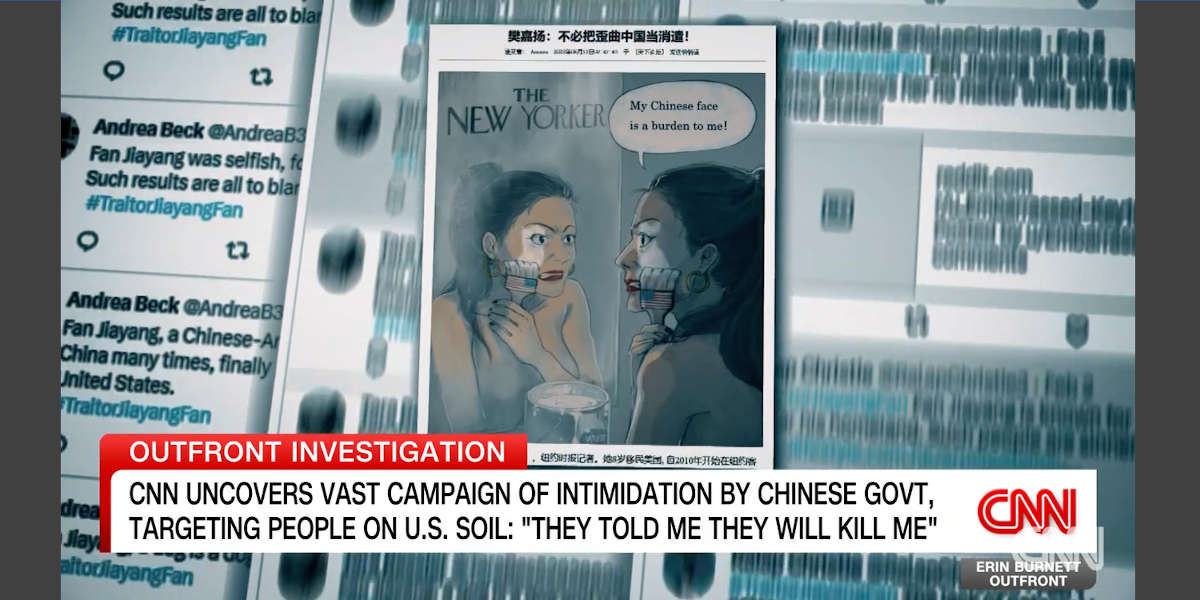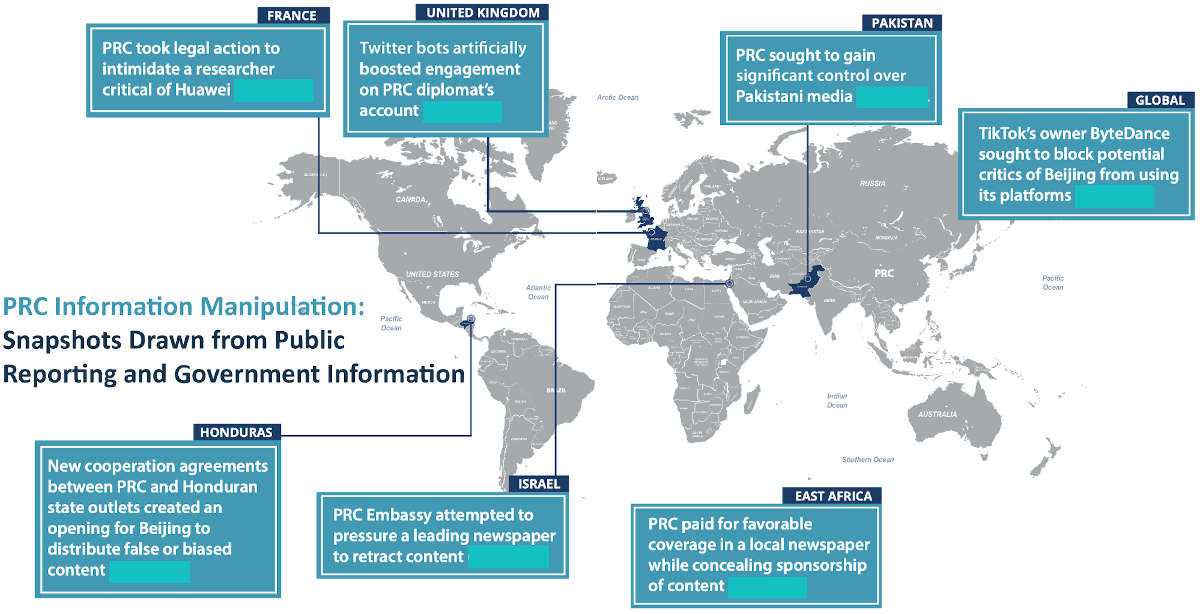In the image
Footage from an especial CNN report about a Beijing's campaign harassing US citizens of Chinese origin
Cyberspace is becoming the battlefield of many conflicts in the 21st century. Media and information are perhaps one of the most menacing weapons, something that comes with no surprises in today’s world. Unfortunately, media control and distortion of information is a common practice that may be attributed to many state actors.
Although each country has the right to portray its own narratives which more often than not serve their interests, this practice is different from manipulating and misconstruing information environments. A practice long attributed to authoritarian states such as the People’s Republic of China (PRC) and its ‘Great Firewall’ domestic restrictions on the internet. Notwithstanding the reproachable nature of this practice that no state should inflict upon their domestic population, in recent years, the international community has become increasingly concerned, due to attempts from the PRC at shaping the information environments at a regional and even global scale and promoting ‘digital authoritarianism.’
The term ‘misinformation campaigns’ refers to a series of mechanisms employed by the PRC, including the spreading of false and misconstrued information, spreading of pro-Beijing propaganda from state-controlled media, censoring of critical voices against the regime, usage of trolls and bots on social media to suppress information that it conceives contrary to its narrative, among other techniques that can be categorized as legally and morally ambiguous to state the least.
These misinformation campaigns, although of recent export into the global arena, have shaped the political and mediatic domestic narrative of the PRC for a long time. Throughout the last decades and under the rule of the Chinese Communist Party (CCP) the Chinese population has endured an extreme censorship regime. A regime that has been toughened since President Xi Jinping entered power. Although this regime of control had only been enforced by the CCP internally, it is believed that since 2017 (when allegedly the first trans-national misinformation campaign was developed) the PRC has exported this practice and throughout the years it has been intensified and the PRC has been successfully improving and adapting these techniques. Although there is no specific figure, it is believed that Beijing invests billions of dollars yearly in the funding of these campaigns. Although these efforts have been employed through different mediums such as academia, partner governments and civil society organizations, it can be argued that the most prominent method through which these efforts are achieved is through media and the digital space.
These new activities of the Chinese government have not gone unnoticed by the international community. On September 28, 2023, Washington officially addressed the issue of Chinese Global disinformation campaigns through a special report by the Global Engagement Center at the US Department of State, titled ‘How the People’s Republic of China Seeks to Reshape the Global Information Environment.’ This 63-page report systematically examines the Chinese disinformation campaigns, their tactics, modus operandi, implications, and consequences. According to the report, Beijing employs mainly five elements, namely: leveraging propaganda and censorship, promoting digital authoritarianism, exploiting international organizations and bilateral partnerships, pairing cooptation and pressure, and exercising control of Chinese-language media.
This analysis aims to showcase and analyze how the People’s Republic of China is actively trying to control and shape media and information environments and reshape global narratives through so-called misinformation campaigns. The objective is also to compare and contrast how these practices take place in East and Southeast Asian countries versus the rest of the world.
Misinformation campaigns in East and Southeast Asia
East and Southeast Asia are without a doubt the regions in the world where the spreading of misinformation campaigns by the PRC are most prominent due to the continuous pressure and influence that Beijing constantly exercises upon its neighbors. The first-ever registered attempt by the PRC at pushing its misinformation campaigns outside of mainland China was recorded in 2019 in the wake of Hong Kong protests. However, as previously mentioned, although of recent export, these practices carried out by the PRC have been employed in many East and Southeast Asian countries. Practices that appear to be more prominent in countries such as Taiwan and others in the region where China has active territorial disputes, namely: Japan, Vietnam, Malaysia, and the Philippines, among others.
Taiwan
To say that the relationship and dynamic between the PRC and Taiwan is complicated is an understatement of the magnitude of the dispute that these countries have had since the last century. The PRC claims Taiwan as one of its provinces and in the last decade its claims to Taiwan have intensified. Due to its interest in Taiwan and the fact that Beijing believes to have a ‘legitimate’ claim to it, the PRC is constantly exerting pressure on Taiwan. The PRC can achieve this through diverse soft and hard power techniques and mechanisms. One of these mechanisms is through its misinformation campaigns.
Taiwan held its most recent presidential elections in January 2024. The election was contested between Lai Ching-te from the Democratic Progressive Party (DPP) who supports the independence of Taiwan, and Hou Yu-ih from the Kuomintang Party, which the PRC is more inclined to. Joseph Wu (Taiwan’s Foreign minister) stated that China had launched interference efforts at every election since Taiwan democratized. Many civil rights groups denounced the flooding of misinformation campaigns carried out by the PRC through social media platforms in the wake of Taiwan’s elections. According to these groups, through fake news and false information, the PRC tried to create an unfavorable image of the DPP candidate, using techniques such as spreading rumors that Hsiao Bi-khim (Lai Ching-te running mate) was a US born citizen and not Taiwanese through various social media platforms.
This is not an isolated event; for example, the PRC has been accused of influencing and amplifying dissenting voices of Taiwanese citizens and civil groups to fuel civil unrest and discontent among the Taiwanese population. Moreover, since 2013, Taiwan has been ranked as the country most targeted by false information. Another example of the PRC misinformation campaigns in Taiwan took place in 2018 when the PRC allegedly spread the rumor through social media that the Tsai administration (DPP) was going to ban the burning of traditional incense due to environmental and climate change concerns. This sparked protests in Taipei with protestors claiming that the Tsai administration was disrespecting the cultural and religious traditions of Buddhists and Taoists.
Disputes in Southeast Asia over the South China Sea
One of the most contentious and ongoing international disputes that the PRC currently has regarding its territorial claims is on the South China Sea and its claim of the ‘Nine-dash line.’ This dispute encompasses a concurrence of maritime claims between China and some countries in the East and Southeast Asian region, namely: Taiwan, Brunei, Malaysia, The Philippines and Vietnam. For this reason, the PRC has carried out a series of heavy misinformation campaigns in terms of historical revisionism, influencing the internal politics of countries in the dispute and favoring politicians that are more lenient towards the PRC and through social media campaigns that favor the PRC’s view on the conflict via bots and fake accounts.
A clear example of this attempt was evidenced when in 2023, the Philippines Coast Guard denounced that the PRC was carrying out a misinformation campaign with the aim of downplaying the Chinese naval belligerence on Philippines waters which they claim as their Exclusive Economic Zone.
Moreover, the PRC’s misinformation campaigns in relation to the South China Sea are evidenced in the pushing forward of historical revisionism regarding their historical claims to many islands. The most contentious islands disputed by China under their historical claims are the Spratly Islands and the Paracel Islands. Through the usage of historical maps and historical references, the PRC aims to shape the narrative and perspective of their conflict by completely disregarding international law and pivotal treaties such as the United Nations Convention on the Law of the Sea. Although the permanent court of arbitration ruled in favor of the Philippines in 2016, due to the lack of legal basis that China had regarding its claims of the Philippines’ territorial waters, the PRC has dismissed these findings and argues that its right to the nine-dash line in the South China Sea is rooted in historical claims and is not fond of the dispute being resolved through the legal route.


